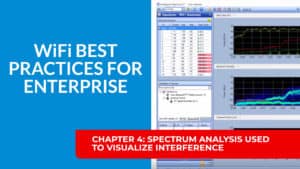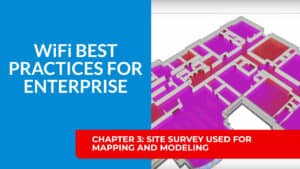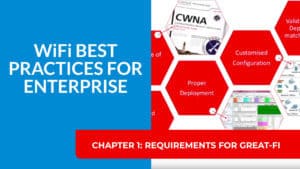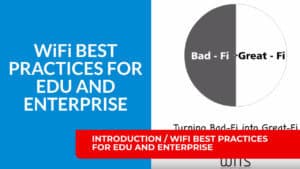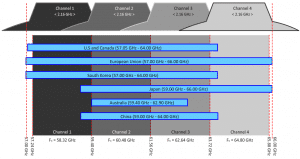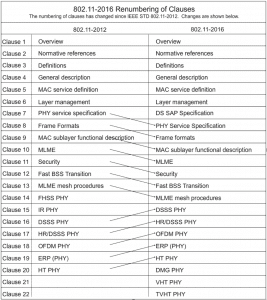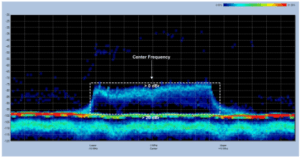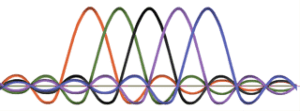Bonded channels can provide additional throughput, but it is important to know how and when to use them to avoid causing other issues. PREVIOUS CHAPTER: Chapter 6 NEXT CHAPTER: Chapter 8
WiFi Best Practices for Enterprise / Chapter 6 – #2 Use all WiFi Channels Supported By Your Clients
Rick explains why taking advantage of all the available channels your clients can support is an important step in avoiding contention on your wireless network. PREVIOUS CHAPTER: Chapter 5 NEXT CHAPTER: Chapter 7
WiFi Best Practices for Enterprise / Chapter 5 – #1 Make 5GHz the Primary Band
This video explains why the 5GHz band is preferred for high priority and high bandwidth clients. Simple steps to make better use of the 5GHz band are discussed. PREVIOUS CHAPTER: Chapter 4 NEXT CHAPTER: Chapter 6
WiFi Best Practices for Enterprise / Chapter 4 – Spectrum Analysis Used to Visualize Interference
This video introduces the 10 WiFi best practices. More detail is given on WiFi Explorer and its configuration for the presentation examples. PREVIOUS CHAPTER: Chapter 3 NEXT CHAPTER: Chapter 5
WiFi Best Practices for Enterprise / Chapter 3 – Site Survey Used For Mapping And Modeling
A real-world example is used to show how RF propagates. PREVIOUS CHAPTER: Chapter 2 NEXT CHAPTER: Chapter 4
WiFi Best Practices for Enterprise / Chapter 2 – The Missing Piece to Great WiFi and WiFi Tools
Rick reveals the missing piece to great WiFi. WiFi Explorer is introduced as the assessment tool that will be used during the presentation examples. After data is collected, the WiTS Scorecard is used as a way to summarize the information collected. PREVIOUS CHAPTER: Chapter 1 NEXT CHAPTER: Chapter 3
WiFi Best Practices for Enterprise / Chapter 1 – Requirements For Great WiFi
This chapter describes what is necessary for a great WiFi experience. Topics include the importance of WiFi knowledge, educated design, proper deployment, customized configuration and design validation. PREVIOUS CHAPTER: Intro NEXT CHAPTER: Chapter 2
WiFi Best Practices for Enterprise / Introduction
This is an introduction to a series of 14 videos covering 10 WiFi best practices for enterprise environments. It is presented by Rick Murphy, author, CTO, CWNE #10 and WLAN Engineer. NEXT CHAPTER: Chapter 1 –
New Spectrum
New Spectrum Status for FCC Regions by Rick Murphy UNII-2B is dead. For more than 4 years, the U.S. Wi-Fi community has anticipated the Federal Communications Commission (FCC) would soon allow unlicensed access to the 5.3 GHz band (5350-5475 MHz) commonly referred to as UNII-2B. This expectation was originally sparked by wording in the 2013 FCC Report […]
802.11ad
Current status of the IEEE 802.11 Task Groups Current Status of the IEEE 802.11 Task Groups (- reprint -) The current roll-up of the 802.11 standard, IEEE Std P802.11-20176 was published in December 2016. This update to the 802.11-2012 standard now adds two new Physical and MAC layer specifications and three, mostly, MAC layer […]
802.11-2016
Exploring 802.11-2016 Amendments – Overview of 802.11ad-2012 Those who are serious about making Wi-Fi work properly, must become students of the 802.11 standard. No matter how hardware manufacturers rebrand the features and services of Wi-Fi as something they invented, all critical interactions between Wi-Fi STAs are blueprinted by the carefully worded clauses that compose the […]
Clause Renumbering
IEEE Std 802.11-2016 now available for free download The latest roll-up of the 802.11 standard is now available for download, free of charge at: http://standards.ieee.org/findstds/standard/802.11-2016.html . This version replaces 802.11-2012 and includes all of the amendments published between 2011-11-11 and 2016-09-01. Those were: 802.11aa-2012 – Video Transport Streams 802.11ae-2012 – Prioritization of Management Frames 802.11ac-2013 […]
Understanding OFDM – Part 5 – new
Spreading Out with 802.11n/ac Figure 29: Spectrum Density View of OFDM Overview of Parts 5 and 6 The last two parts of this tutorial will show the evolution from Legacy (802.11 and 802.11b) and Classical (802.11a and 802.11g) WLAN protocols to our current state of the science, which began with the release of 802.11n in […]
Understanding OFDM – Part 4 – Refresh
RF Noise – The Sound of Silence Figure 17: Noise floor with 802.11 signal in Channel 11 Overview of Radio Energy In the previous episode of “Understanding OFDM”, we discussed the effects that convolutional coding error correction has on our overall channel data rates. The reason for using an error correction mechanism is to attempt […]
Understanding OFDM – Part 3 – Refresh
So You Say You Want a Convolution Figure 12: Bits to Encode In Part 2 of this series, we determined the maximum baud rate for 802.11a/g, and calculated the maximum channel data rates by modulation type. As an example, if using a BPSK modulation type we arrive at raw channel data rate of 12 Mbps, […]
Understanding OFDM – Part 2 – Refresh
Figure 5: OFDM Waveform Introduction OFDM is simple in theory. A fast, serial data stream (your baseband user data for instance) is divided by means of a “serial-to-parallel” conversion, into multiple, slower data streams. In addition, the allocated RF channel, which in 802.11a/g is 20 MHz wide, is divided into many smaller frequency groups known as […]



